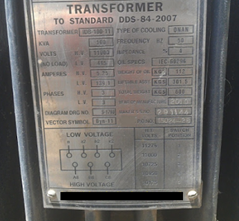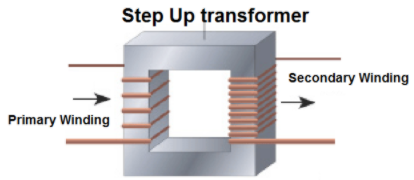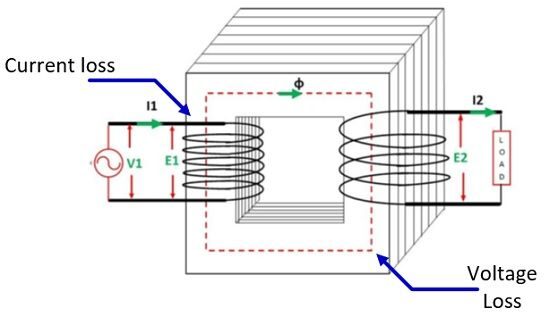
Transformers are important components in electrical power systems and enable the efficient transmission and distribution of electricity. Knowing the kilovolt-amperes (kVA) rating of a transformer is essential for the proper selection, installation, and operation of these devices. In this article, we uncover the basics of transformer power in kVA, decipher the factors that influence it, and examine the underlying calculation methods. By exploring this topic, we can better understand how to determine the appropriate transformer rating to meet specific performance requirements.
In this tutorial we will find the transformer power in KVA.
We know that the nominal power of transformers is always in kVA.
Below are the two simple formulas to determine the rated power of single-phase and three-phase transformers.
Single phase transformer classification
The rated power of a single-phase transformer can be determined using the power formula P = V x I, where P is the apparent power in volt-amperes (VA), V is the voltage in volts (V), and I is the current in amps (A). However, it is important to note that this formula provides the apparent power, which is the product of voltage and current without taking the power factor into account.
P = V x I
Power of a single-phase transformer in kVA
To calculate the apparent power in kVA (kilovolt-amperes), the formula can be modified as follows:
kVA = (V x I) / 1000
Here is a step-by-step guide to calculating the apparent power of a single-phase transformer:
Determine the voltage
Measure or determine the voltage level (V) at which the transformer operates. Depending on the application, this may be the primary or secondary voltage.
Determine the current
Measure or determine the current (I) flowing through the transformer. Depending on the application, this can be the primary or secondary current.
Calculate the apparent power.
Multiply the voltage (V) by the current (I) and divide the result by 1000 to obtain the apparent power in kilovolt-amperes (kVA).
kVA = (V x I) / 1000
It is important to note that the apparent power determined from this formula represents the maximum capacity of the transformer in terms of voltage and current handling without taking into account the power factor. The power factor takes into account the phase difference between the voltage and current waveforms and determines the actual power (kW) that the transformer delivers.
The power factor must be considered to determine the rated power (kW) of the transformer. The relationship between apparent power (kVA), real power (kW) and power factor (PF) is given by:
kW = kVA x power factor
PF stands for power factor (usually between 0 and 1).
In summary, the nominal power of a single-phase transformer can be determined using the power formula P = V x I, where P represents the apparent power in VA. To obtain the nominal apparent power in kVA, divide the result by 1000. However, to determine the nominal power (kW), the power factor must be taken into account.

Evaluation of a three-phase transformer
The rated power of a three-phase transformer can be determined using the power formula P = √3 × V × I, where P is the apparent power in volt-amperes (VA), V is the phase-to-phase voltage in volts (V) , and I is the line current in amps (A).
P = √3V x I
Power of a three-phase transformer in kVA
KVA = (√3V x I) /1000
How to calculate the apparent power of a three-phase transformer step by step:
Determine the interconnect voltage.
Measure or determine the line-to-line voltage (V) at which the transformer operates. This is the voltage between any two phases of the three-phase system.
Determine the line current.
Measure or determine the line current (I) flowing through the transformer. This is the current in one of the lines of the three-phase system.
Calculate the apparent power.
Multiply the line voltage (V) by the line current (I) and multiply the result by the square root of 3 (√3). This gives the apparent power of the three-phase transformer in volt-amperes (VA).
Apparent power (VA) = √3 × V × I
It is important to highlight that the apparent power determined from this formula represents the maximum capacity of the three-phase transformer in terms of voltage and current treatment without taking into account the power factor.
To determine the real power (kW) of the three-phase transformer, the power factor (PF) must be taken into account. The relationship between apparent power (VA), real power (kW) and power factor is given by
Real power (kW) = Apparent power (VA) × Power factor (PF). PF stands for power factor (usually a value between 0 and 1).
In summary, the power of a three-phase transformer can be determined using the power formula P = √3 × V × I, where P represents the apparent power in VA. The apparent power determined from this formula corresponds to the maximum capacity of the transformer. To determine the real power (kW), the power factor must be taken into account.

For example, the figure above shows that the transformer power rating is 100 transformer voltages or high voltages (HV) of 11,000 V = 11 kV.
The direct current on the high voltage side is 5.25 amps
AND
Secondary voltages or low voltages (BT) are 415 volts
The secondary current (current on the low voltage side) is 139.1 amps
Transformer power calculation methods
When calculating transformer performance, several parameters must be carefully considered. A common method is based on expected load requirements and takes into account factors such as load type (continuous or intermittent) and load diversity. Load diversity takes into account the probability that not all connected loads will operate at maximum capacity at the same time. Other calculation methods take into account standards and guidelines specific to the industry and intended application, power quality requirements, and safety margins.
Now let's see how to calculate the power of a transformer
P = V x I (primary voltage x primary current)
P = 11,000 V x 5.25 A = 57,750 VA = 57.75 kVA
Or P = V x I (secondary voltages x secondary current)
P = 415V x 139.1A = 57,726VA = 57.72kVA
We found out that the power of the transformer (in the transformer) is 100 kVA, but by calculation… it is about 57 kVA
The difference comes from the lack of awareness that we use a single-phase formula instead of a three-phase recipe.
Now let's use this formula
P = √3 x V x I
P=√3 Vx I (primary voltage x primary current)
P =√3 x 11000V x 5.25A = 1.732 x 11000V x 5.25A = 100.025VA (or)
P=100KVA
Or
P = √3 x V x I (secondary voltages x secondary current)
P = √3 x 415V x 139.1A = 1.732 x 415V x 139.1A = 99.985VA (or)
P = 99.98kVA
Consider the (next) example below.
Voltage (line to line) = 208 V.
Current (line current) = 139 A
Now three phase transformer review
P = √3Transformer = √3 x 208 x 139A = 1.732 x 208 x 139
P = 50077VA = 50kVA
Conclusion
In summary, understanding the fundamentals of transformer performance in kVA is critical to the selection and operation of transformers in electrical power systems. By considering factors such as load requirements, voltage levels, power factor and expected future growth, engineers can determine an appropriate rating that ensures optimal performance, reliability and safety. Accurately calculating transformer power plays a crucial role in achieving efficient power transmission and distribution and preventing problems such as equipment malfunctions, power outages and system failures. As the energy industry continues to evolve, staying abreast of new trends and advancements allows engineers to adapt calculation methods and make informed decisions regarding transformer performance to meet the ever-changing needs of electrical infrastructure.

